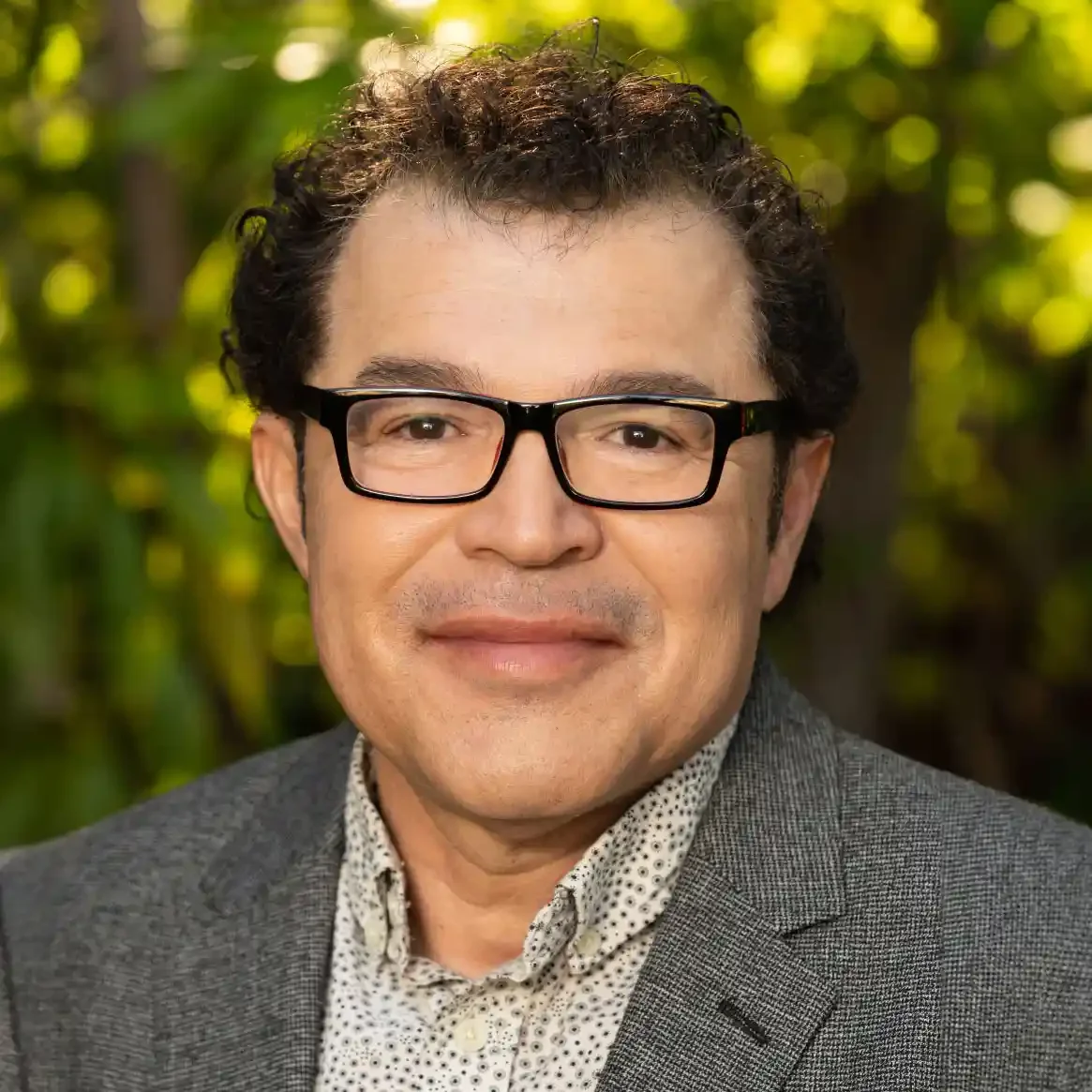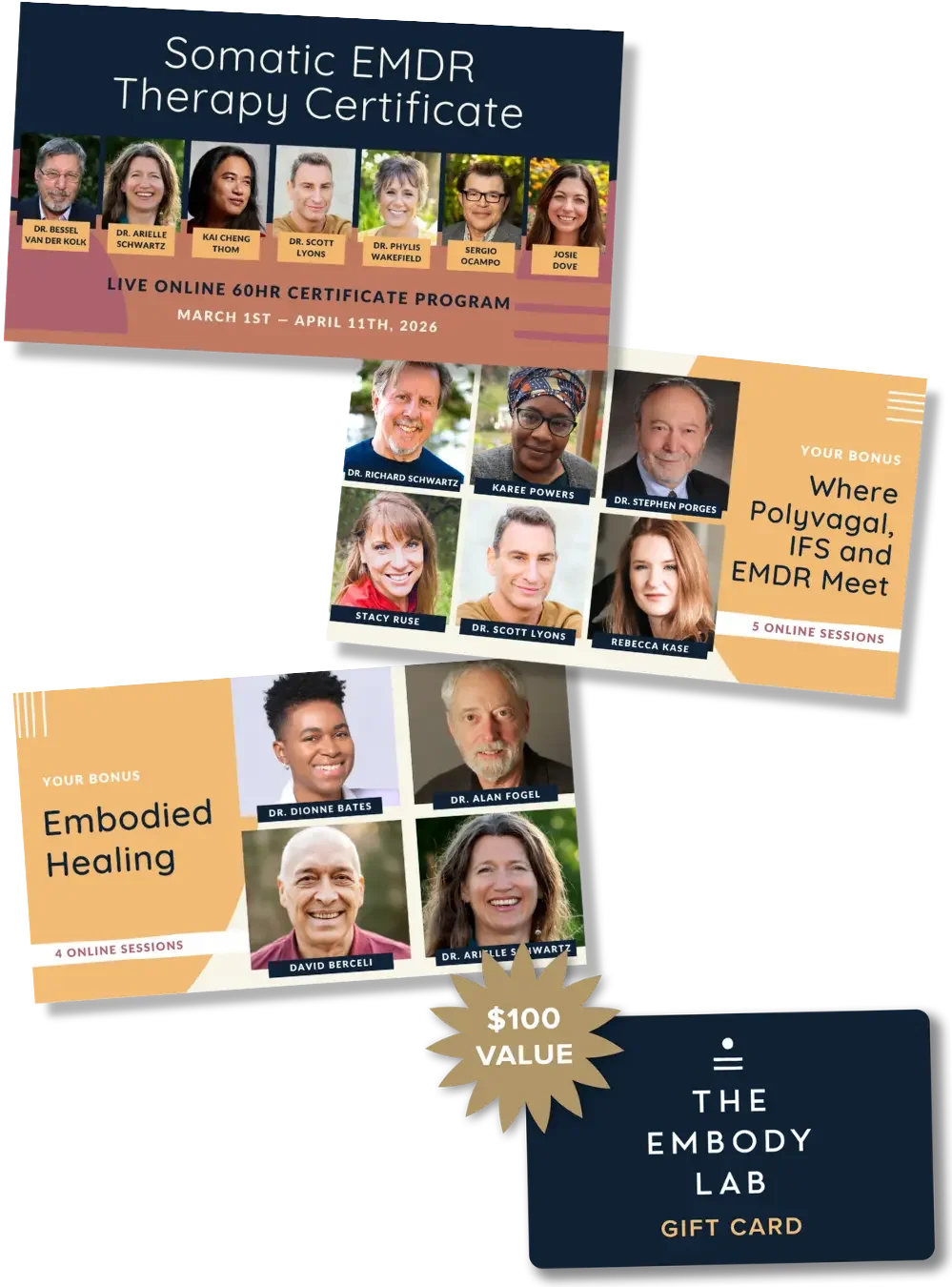
SOMATIC EMDR THERAPY CERTIFICATE
“Thriving is our birthright. Healing individual and collective trauma is the deepest embodiment of this truth.”
— DR. SCOTT LYONS

PROGRAM AT-A-GLANCE
Are you looking for a way to help your clients heal from trauma more effectively and holistically? Do you want to learn how to integrate EMDR therapy and somatic psychology in your trauma treatment practice? Or daily life as a way to process stress, release what's holding you back, and expand your resilience?
This program is designed for individuals, practitioners and educators who want to discover the power of a unified somatic approach to EMDR therapy to address and repair the psychological and physiological effects of trauma. When brought together these two cutting-edge modalities help process traumatic memories and reduce emotional distress, while reconnecting with the body and restoring a sense of safety and agency. In fact, according to Trauma expert Bessel van der Kolk, Somatic Therapy and EMDR Therapy are considered the best approaches for the treatment of trauma.
In this unique online certificate program, you will learn how to combine these approaches using evidence-based techniques and strategies and discover the latest research and interventions to enhance embodiment and healing in yourself and your clients. You will also benefit from interactive learning, practical exercises, and peer support.
This is more than an EMDR training! Taught by world-leading faculty, this program will equip you with the skills and confidence to offer your clients a comprehensive and unified approach to Somatic EMDR including body-based interventions that can radically improve the effectiveness of EMDR Therapy, which translates into a significant experience of well-being.
Join us and discover the power of a unified somatic approach to EMDR therapy to heal trauma and restore agency for yourself and your clients. Register now and get ready to transform your practice and your clients' lives.

MEET YOUR INSTRUCTORS
Internationally recognized leaders bring to life a holistic and unified somatic EMDR therapy curriculum.
DR. BESSEL VAN DER KOLK
KAI CHENG THOM
DR. ARIELLE SCHWARTZ
DR. SCOTT LYONS
SERGIO OCAMPO
DR. PHYLIS WAKEFIELD
JOSIE DOVE

LEARN MORE WITH OUR FREE PREVIEW EVENT
FREE, LIVE & ONLINE:
Sunday, January 11th, 2026 from 3 - 4:30pm ET

ABOUT THE PROGRAM
This unique 60-hour online certificate program is designed for individuals, practitioners and educators wanting to explore a unified somatic approach to EMDR therapy to address and repair the psychological and physiological effects of trauma. When brought together these two cutting-edge modalities help process traumatic memories and reduce emotional distress, while reconnecting with the body and restoring a sense of safety and agency.
Bringing together world-renowned Somatic EMDR Therapy teachers into one program, this extraordinary program offers a collection of practical tools, embodied theory, and protocols that will inspire and empower you, while guiding you through this effective and powerful healing process for yourself and your work with others
What is somatics?
‘Soma’ is a Greek word for ‘the living body known from within’, or known to the Self. This ‘knowing’ signifies wholeness. Somatic therapy is an experiential approach towards mindbody integration. The pain, overwhelm, and coping responses manifested by trauma take us away from feeling at home in our body, and as a result there is often a split within ourselves.
Somatic Therapy helps:
Restore the body as a place of safety while helping to expand the capacity to process body (preverbal and nonverbal) memory
Metabolize unprocessed emotions
Complete thwarted (incomplete) stress responses
Restore our optimal relationship to our self and the world around us
Somatic trauma therapy offers techniques for clients to sense and regulate their own physiology and states of being. This includes building more internal and external resources, building trusting and co-regulatory relationships, learning to turn inward with compassion, being invited deeper in the body, and given time and space to process the trauma. These somatic techniques unwind trauma and restore well-being.
What is Somatic EMDR?
“The synthesis of somatic psychology and EMDR Therapy is an exciting advancement in mental health. As stand-alone therapies these are now considered to be two of the best trauma treatment models available. Integrating these therapies enhances the effectiveness of both.”
— Dr. Arielle Schwartz
According to Trauma expert Bessel van der Kolk, Somatic Therapy and EMDR Therapy are considered the best approaches for the treatment of trauma.
Eye Movement Desensitization and Reprocessing (EMDR) Therapy is a comprehensive approach to therapy that integrates elements of psychodynamic, cognitive behavioral, interpersonal, experiential, and body-centered therapies to maximize treatment effects. EMDR Therapy uses a structured protocol for the treatment of Post Traumatic Stress Disorder (PTSD) and related past experiences that trigger emotions, beliefs, sensations.
Somatic Psychology offers key concepts and interventions that are necessary for a unified Somatic approach to EMDR. Somatic Interventions such as tracking sensations, deepening awareness, boundary awareness, and self-regulation complement and increase the efficacy of EMDR Therapy and collectively these therapeutic modalities offer a profound healing tool for anyone facing the pain of PTSD.
Somatic EMDR can help your client identify the root of their pain and what’s holding them back, change the negative thoughts cluttering their mind, restore their sense of safety and vitality, process traumatic memories and reduce emotional distress…. all the while helping them to reconnect with their body, and restore safety and agency.
This is a profound healing tool for anyone facing the pain of trauma.
Research also shows Somatic EMDR can decrease chronic pain, improve relaxation, and enhance well-being and self-esteem. And best of all Somatic EMDR is known to get results, fast. While everyone's journey is different, 80% to 90% of people report positive results within their first three sessions.
In this program we’ll explore key interventions and tools of Somatic Psychology to enhance the effectiveness of EMDR. These include:
Grounding: Grounding refers to our ability to experience ourselves as embodied. Traumatic events are by nature overwhelming and to incorporate these painful experiences our mind often replays the event again and again. As a result, we develop a host of avoidance strategies so we do not have to experience the pain. We cut off awareness of sensations; we go numb. Grounding involves sensing the body, feeling your feet on the earth, and calming the nervous system.
Cultivating Somatic Awareness: When a client retells the story about unresolved traumatic events, the somatic therapist promotes awareness of the body. Teaching clients how to develop and sustain somatic awareness is the first step in the integration of body-centered work into EMDR Therapy.
Resourcing: Resource development is a technique emphasized equally within both EMDR Therapy and Somatic Psychotherapy. When we help clients develop resources we focus on increasing a sense of choice and safety.
Titration: When we turn our attention to traumatic events our body-centered awareness helps us become conscious of our physical tension patterns. Titration refers to a process of experiencing small amounts of distress at a time with a goal to discharge the tension. During EMDR Therapy, titration is also a key component of managing high levels of distress and reducing the likelihood of re-traumatization during the healing process.
Sequencing: When somatic tension begins to discharge or release, clients typically report the movement of emotion and sensations. Here, we invite the client to experience these sensations without inhibiting them and to simply observe them as they change. The tension eventually releases–sometimes in the form of tears, an ability to breathe more freely, or possibly the feeling of lightness.
Movement and Process: In EMDR Therapy, the Adaptive Information Processing model posits that when given an opportunity to process through a traumatic event clients have an inherent, natural healing process.
EMDR uses bilateral stimulation (i.e eye movement, tapping, etc.) to attend to and deesclate the reactivity to past memories, present triggers, or anticipated future experiences. Somatic EMDR also utilizes movement techniques to help complete unprocessed nervous system impulses and frozen emotions that have been previously stuck in the body.
A unified Somatic approach to EMDR allows us to tap into our innate healing capacity by inviting us to listen to the story as told by the body, whilst working with a comprehensive, structured approach to healing and processing traumatic memories and their associated beliefs, emotions, and sensations. This also includes completing unprocessed nervous system impulses through movement.
Join us and discover the power of a unified somatic approach to EMDR therapy to heal trauma and restore agency for yourself and your clients. Register now and get ready to transform your practice and your clients' lives.

WHAT IS TRAUMA
A holistic approach to trauma defines trauma not as an event, but rather as a disruption and overwhelm to our body-mind’s capacity to adapt, thrive, and flourish.
Trauma can occur when:
There is too much too soon
There is too much for too long
There is not enough for too long
Power and agency have been taken away from the person or collective
The stressors outweigh the resources available to navigate them
When our primal protective instincts, intuitions, and responses are thwarted
There is not enough time, space, or permission to heal
It is essential that we consider social, developmental, and cultural factors when reflecting on a client’s trauma history. By not acknowledging these contextual factors we do the individual a disservice.
The symptoms of trauma may occur immediately or emerge over time from the compounding stress and challenges of processing and adapting to the experiences of life. Symptoms of trauma emerge as the body and mind attempt to cope with and resolve the stressors.
Trauma can lead to feelings of powerlessness, helplessness, and groundlessness. It interferes with our ability to feel real in body and mind, it disrupts our very sense of existence, and takes us away from the present moment. However, as Dr. Peter Levine, creator of Somatic Experiencing says “Trauma is a fact of life. It does not have to be a life sentence.”
Symptoms are the gateway to healing trauma. Our job as practitioners and educators is to listen and hear the messages and wisdom encoded in the body.
Somatic Therapy helps:
Restore the body as a place of safety while helping to expand the capacity to process body (preverbal and nonverbal) memory
Metabolize unprocessed emotions
Complete thwarted (incomplete) stress responses
Restore our optimal relationship to our self and the world around us
Somatic trauma therapy offers techniques for clients to sense and regulate their own physiology and states of being. This includes building more internal and external resources, building trusting and co-regulatory relationships, learning to turn inward with compassion, being invited deeper in the body, and given time and space to process the trauma. These somatic techniques unwind trauma and restore well being.

“Healing is never complete until we have been truly heard. May the universe send you someone who will sincerely care to listen.”
- ANTHON ST. MAARTEN

“Healing is like an onion. As you process through one layer of trauma to release the pain and heal, a new layer will surface. One layer after another layer will bring up new issues to focus on. Pace yourself. Only focus on one layer at a time.”
- DANA ARCURI

“The body stores the trauma of our lives in muscular rigidity, thereby keeping us stuck in the past. When we release the tension in the body and align ourselves with gravity, we take a new stand in life. This allows us to be at ease with ourselves and in harmony in our relationship to others and to our planet.”
- JOSEPH HELLER

“Sometimes the people around you won't understand your journey. They don't need to, it's not for them.”
- JOUBERT BOTHA
CURRICULUM
This 60-hour certificate program consists of a Student Orientation session on Sunday, March 1st, 2026 followed by 28 two-hour sessions offered over 6 weeks from March 2nd to April 11th, 2026. Classes are on Mondays, Wednesdays and Saturdays. The program also includes optional Community Connections.
WEEK 1 - Foundations of EMDR and Somatics
Orientation to EMDR and Somatics
Introduction to Somatic EMDR
Rings of Trauma
Presencing Skills and Resilience
Somatic Dialogue Skills
Part I EMDR Basic Protocol: Phases 1 - 2
WEEK 2 - Deepening EMDR and Somatic Processing: Psychobiological Regulation and Bilateral Stimulation
Polyvagal Theory
Part II EMDR Basic Protocol: phases 3 - 8
Bilateral alternatives for Somatic EMDR
Processing Skills
WEEK 3 - Somatic EMDR Protocol: Healing The Past, Present, & Future
Somatic EMDR Protocol and Practice
Somatic EMDR Demos
EMDR for Generational and Cultural Trauma
Complex PTSD, Dissociation, and Parts Work
WEEK 4 - Integration: Weaving It All Together
Special topics - Chronic Pain & Addiction
Special Topics & Group / Self EMDR Practice
Arc of a Session
Practice Sessions and Integration
Self Care & Q&A
WHO IS THIS PROGRAM FOR?
• Social Workers
• Mental Health & Pastoral Counselors
• Yoga Therapists / Yoga Teachers
• Movement Therapists
• Physicians (MD, DO, ND, DC & others) & Physician Assistants
• Coaches
• Nurses & Nurse Practitioners
• Psychologists
• Emergency Medical Personnel
• Meditation Teachers
• Educators
• Massage Therapists & Body Workers
• Acupuncturists
• Hypnotherapists
• Kinesiologists
• Complementary & Alternative Medicine Professionals
• Clergy & Religious Leaders
• Other Wellness Professionals

WHAT YOU’LL LEARN
Foundations of EMDR
Learn the 8 phases of EMDR Therapy as an evidence-based approach to trauma treatment.
Embody the therapist’s role in an EMDR session through guidance and co-regulation.
Help clients build affect or sensation tolerance and readiness for traumatic memory reprocessing.
Address the strengths and limitations of the EMDR standard protocol.
Develop the skills and confidence to approach the EMDR framework with flexibility.
How to work with blocks in EMDR processing.
Learn techniques for memory reprocessing through bilateral stimulation.
Somatic Focus & Interventions
Somatic dialogue & processing skills.
Identify somatic signs of “subtle dissociation” and apply tools of embodied resilience.
Guide clients into self awareness, resourcing, and connection to their felt sense for deeper processing.
Advanced bilateral stimulation techniques for full body processing.
Mobilizing stuck arousal energy for completion of trauma reprocessing.
Somatic psychology interventions to all phases of the traditional EMDR Protocol.
A new comprehensive & integrative somatic EMDR protocol.
Learn how to do a person centered Somatic EMDR session (from beginning to end).
Special Topics
Apply Somatic EMDR Therapy within a culturally sensitive framework inclusive of transgenerational and collective traumatic events.
Modify the Somatic EMDR protocol for individuals with dissociative symptoms or C-PTSD.
Integrate parts work therapy & Applied Polyvagal Theory into Somatic EMDR Therapy.
Learn how to utilize somatic EMDR for individual and Groups.
Learn somatic EMDR protocols for addiction and pain management.
How to create safe enough spaces for complex trauma and individuals from marginalized communities throughout the EMDR process.

PROGRAM INTENTIONS
Weaving together the research based EMDR therapy protocol with the healing power of somatic approaches (body-based therapies).
Create opportunities for participants to connect as a community and connect via shared interest of applications.
Approach trauma treatment through a strength-based and resilience-informed lens.
A flexible approach to a traditional modality, that allows practitioners to navigate the nuances of trauma in each individuals manifestation of it.
Skillfully address adaptive survival patterns, blocks in healing processes and dissociation.
Support practitioners to enhance their sensory awareness and presence for moment to moment tracking and skillful guidance during the healing processes.
Sessions will include at least two practical skills that can be applied to integrate the educational material.
Opportunities to observe demonstration sessions and to engage in practice sessions to strengthen your practitioner skills.

PROGRAM DETAILS
PROGRAM SCHEDULE
This 60 hour certificate program will run live from Sunday, March 1st to Saturday, April 11th, 2026. A detailed schedule will be provided when registering. All live sessions will be recorded and students may watch in their own time:
STUDENT ORIENTATION: Sunday, March 1st, 2026 from 5 - 6:30pm ET
WEEKLY CLASSES: Monday, March 2nd through Saturday, April 11th, 2026. All weekly classes are on:
Mondays from 7 - 9pm ET
Wednesdays from 5 - 7pm ET
Saturdays from 10 - 12pm ET, 12:45 - 2:45pm ET, and 3:30 - 5:30pm ET
one Thursday class on April 2nd, 2026 from 10am - 11:30am ET
No classes on Wednesday, April 1st or Monday, April 6th, 2026
COMMUNITY SESSIONS (optional):
Tuesday, March 3rd, 2026 from 3 - 4:30pm ET
Tuesday, March 17th, 2026 from 3 - 4:30pm ET
Because of the complexities with international time zones, we have only listed Eastern Time (ET) above. Please check how this translates into your local Time Zone here.
HOMEWORK
There are no homework assignments during the program. Please see Certificate of Completion below for more information.
LEARNING PLATFORM FORMAT
ZOOM: The live portion of the certificate program will be offered online using the video conferencing platform Zoom, in meeting format, to allow instructors and students to interact, ask questions and participate in breakout sessions.
ONLINE LEARNING PLATFORM: The online learning platform will host all the information about the course including:
Detailed schedule and reminder emails of upcoming sessions
How to access via Zoom
All recordings will be available within 48 hours of the end of the live event.
Supporting materials such as PDFs of the reading material and presentations
ACCESSIBILITY
VIDEO / AUDIO: Within the online learning platform, students may watch the video within their online library or download the video or audio to their computer. They will have lifetime access to the content.
LIVE CAPTIONING / TRANSCRIPTS: Captioning during live sessions and transcripts will be offered in English.
READING LISTS: Each instructor will provide required or recommended readings.
• Required readings will be available freely online or in PDF format.
• Recommended readings are optional and for futher exploration. They may include books, online articles etc.
• PDFs of the instructor’s presentation will also be provided.
CERTIFICATE OF COMPLETION
Below are the requirements to receive the Certificate of Completion:
Attend the live sessions or watch the recordings
Complete the Self Evaluation
Complete 10 sessions (45 mins or longer) outside of class times. A session is considered a practice together with the application of the tools learned.
REGISTRATION / ENROLLMENT / TUITION
Enroll for the certificate program by choosing one of the two payment options— $977 for The Embody Lab Members or the standard price of $1227. Payment plans are available at checkout for both payment options. Enroll here →

FREQUENTLY ASKED QUESTIONS
+ Who is this program designed for?
This program is a certification process that distills an educational methodology to integrate into a variety of modalities such as:
Social Workers, Mental Health & Pastoral Counselors, Yoga Therapists / Yoga Teachers, Movement Therapists, Coaches, Physicians (MD, DO, ND, DC & others) & Physician Assistants, Nurses & Nurse Practitioners, Psychologists, Emergency Medical Personnel, Meditation Teachers, Educators, Massage Therapists, Acupuncturists & Body Workers, Hypnotherapists, Kinesiologists, Complementary & Alternative Medicine Professionals, Clergy & Religious Leaders, other Wellness Professionals.
This is an education program and not a licenser program.
+ What are the dates, schedule and time commitment?
This 60 hour certificate program will run live from Sunday, March 1st to Saturday, April 11th, 2026. A detailed schedule will be provided when registering. All live sessions will be recorded and students may watch in their own time:
STUDENT ORIENTATION
Sunday, March 1st, 2026 from 5 - 6:30pm ET
WEEKLY CLASSES
Monday, March 2nd through Saturday, April 11th, 2026. All weekly classes are on:
- Mondays from 7 - 9pm ET
- Wednesdays from 5 - 7pm ET
- Saturdays from 10 - 12pm ET, 12:45 - 2:45pm ET, and 3:30 - 5:30pm ET
- one Thursday class on April 2nd, 2026 from 10am - 11:30am ET
- No classes on Wednesday, April 1st or Monday, April 6th, 2026
2 COMMUNITY CONNECTIONS
- Tuesday, March 3rd, 2026 from 3 - 4:30pm ET
- Tuesday, March 17th, 2026 from 3 - 4:30pm ET
+ Will there be an orientation session?
Yes, there will be an orientation session on Sunday, March 1st, 2026 from 5 - 6:30pm ET.
+ Do I need to attend live or am I able to watch recordings?
All live sessions will also be recorded and students may watch in their own time (more information below). Please note, captioning is only available during live sessions.
+ How can I interact with the instructors? Will I receive guidance?
During each of the live sessions, the instructors will have a Q&A period where you may ask questions. Two community connections will also be offered with the faculty. A private online community forum will also be provided for the certificate.
+ What are the homework requirements?
There are no homework assignments during the program.
+ Do you offer scholarships?
For every 200 enrolled students, we are able to offer:
- 10 Full Scholarships (100%)
- 10 Partial Scholarships (50%)
How to Apply:
- Please complete this scholarship form by 11:59pm ET on Saturday, February 7th, 2026.
- Scholarship results will be communicated by end of day Sunday, February 15th, 2026.
+ Is there a deadline for registration?
Registration is open until the day before the student orientation. Please enroll by February 28th, 2026.
+ Do you offer refunds?
We offer a Registration Guarantee which means that if you register but decide the course isn’t right for you, we’ll refund your course fee - no questions asked - up to 48 hours before the course start date.
+ How can I access the online course and recordings?
ZOOM FOR LIVE SESSIONS: The live portion of the certificate program will be offered online using the video conferencing platform Zoom, in meeting format, to allow instructors and students to interact, ask questions and participate in breakout sessions.
ONLINE LEARNING PLATFORM: Once you register, you will receive access to our online learning platform which will include all the information about the certificate, including:
- Detailed schedules
- How to access the live sessions via Zoom
- Recordings of all live sessions uploaded within 48 hours of the end of the live session
- Supporting materials provided by your instructors
ACCESSIBILITY | Video / Audio: Within our online learning platform, you may watch the video within your online library or download the video or audio to your computer. You will have lifetime access to the content.
ACCESSIBILITY | Live Captioning / Transcripts: Captioning during live sessions and transcripts will be offered in English.
ACCESSIBILITY | Reading Lists: The reading list will include items available at the public library or will be provided as a PDF where possible. PDFs of the instructor’s presentation will also be provided.
+ Is this a summit?
No, this is an integrated curriculum co-created by the faculty. The faculty are colleagues in this program. They are working together to make sure each individual module is cohesive with the entire curriculum. Every teacher is informed about what is coming before and what is coming after and integrating their curriculum based on that information.
+ Is this a theoretical or practical (experiential) program?
While some theory will be presented to support the learning, the primary focus of the practice is experiential, giving practical tools for the participants.
+ Will I receive a certificate?
All students who complete the requirements below will receive a Certificate of Completion from The Embody Lab. The requirements to receive the Certificate are:
- Attend the live sessions or watch the recordings.
- Complete the Self Evaluation after each module.
- Complete 10 sessions (45 mins or longer) outside of class times. A session is considered a practice together with the application of the tools learned.
- Dates to complete by July 4th, 2026 (3 months after the last live session).
+ After completing the EMDR certificate program, what title am I allowed to use?
Licensed therapists or health professionals (e.g., social workers, psychologists, clinical therapists, registered nurses) may use the title "Somatic EMDR Practitioner".
Non-licensed individuals may say:
"I integrate somatic EMDR interventions into my practice."
+ How is this certification different from EMDRIA? Can I practice EMDR without being EMDRIA certified?
This program provides in-depth training in integrative somatic EMDR approaches but does not grant EMDRIA certification. EMDRIA certification has specific requirements, including training from an EMDRIA-approved provider. Additionally, EMDRIA does not allow for the integration of somatic approaches, which The Embody Lab considers vital for best practices in trauma treatment. This program is designed for professionals seeking to incorporate EMDR techniques with a somatic framework in their practice.
+ Will Continuing Education Units (CEUs) be offered?
CONTINUING EDUCATION CREDITS FOR HEALTH PROFESSIONALS
More information will be provided on the number of CEs available for this program and how to register. Please note - Live attendance is required.
To register your interest for CE credits for this program and more detailed information, please visit this link: https://forms.gle/76mwhjgG5vnzVw9BA
Below is more information on the health professionals which may be eligible for CEs through the Spiritual Competency Academy (SCA) which is co-sponsoring this program.
- CE credits for psychologists are provided by the Spiritual Competency Academy (SCA) which is sponsoring this program. The Spiritual Competency Academy is approved by the American Psychological Association to sponsor continuing education for psychologists. Spiritual Competency Academy maintains responsibility for this program and its content.
- The California Board of Behavioral Sciences accepts CE credits for LCSW, LPCC, LEP, and LMFT license renewal for programs offered by sponsors of CE who are approved by the American Psychological Association.
- LCSW, LPCC, LEP and LMFTs, and other professionals from outside of California need to check with their state licensing board as to whether or not they accept credits from programs offered by approved sponsors of CE by the American Psychological Association.
- SCA is approved by the California Board of Registered Nursing (BRN Provider CEP16887) for licensed nurses in California. RNs must retain their certificate of attendance for 4 years after the course concludes. Nurses outside of California must confirm acceptance with their licensing boards.
- For questions about your certificate or the content, logistics, or other support issues regarding this course, please contact The Embody Lab at info@theembodylab.com.
- For questions about whether APA CE is valid for you, contact your licensing board directly.
- For general questions about APA CE, contact SCA at ce@spiritualcompetencyacademy.com.
FROM A DIFFERENT STATE OR COUNTRY?
Health professionals from a state or country outside of California need to check with their licensing boards as to whether or not they accept programs offered by approved sponsors of Continuing Education by the American Psychological Association (APA).
DIFFERENT CREDENTIAL?
If your credential is not listed, please check with your licensing board as to whether or not they accept programs offered by approved sponsors of Continuing Education by the American Psychological Association (APA).
The SCA and The Embody Lab are not able to determine your eligibility.

YOUR QUESTIONS ANSWERED
SOMATICS WERE MISSING
WHAT IS SOMATIC EMDR?
WHO CAN JOIN THE PROGRAM?
I’M A COACH. IS THIS PROGRAM FOR ME?
WILL I REPEAT WHAT I ALREADY KNOW IF I’VE ALREADY COMPLETED EMDR TRAINING?
✨ JOIN US TODAY FOR JUST $977 AND RECEIVE...
✓ 60-hour Somatic EMDR Therapy Certificate
✓ BONUS Where Polyvagal, IFS and EMDR Meet package
✓ BONUS Embodied Healing package
✓ BONUS $100 Embody Lab Gift Card
You must register by January 14th, 2026 to receive your free bonuses!
TOTAL VALUE $1936
YOU SAVE $959 ✨

PROGRAM REGISTRATION
A unified somatic approach to EMDR therapy for trauma repair.
REGISTER FOR THE LIVE CERTIFICATE NOW
PAYMENT PLAN AVAILABLE AT CHECKOUT.
Upon registration you will receive a welcome email with details on how to access the program.
You will have lifetime access to the on-demand training sessions.
Program valued at $1936
Non-Members pay only...
$1227 USD
SAVE $709 AND JOIN THE REVOLUTION OF COMING HOME TO THE BODY!
PAYMENT PLANS AVAILABLE AT CHECKOUT
Program valued at $1936
ONLY $977 USD
MEMBERS SAVE $959
NOT A MEMBER? JOIN FREE FOR 30 DAYS AT CHECKOUT & SAVE!*
PAYMENT PLANS AVAILABLE AT CHECKOUT
*30-Days FREE Membership trial is included with your purchase. After 30-days you pay $26 per month. Cancel at anytime.












